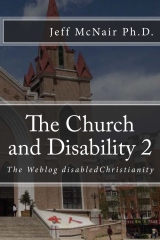In 1972, Dr. Wolf Wolfensberger, wrote about what he called deviant role perceptions. These were ways in which persons with disability were sometimes perceived. The word "deviant" should be thought of in terms of differing from the norm (American Heritage dictionary). The word deviant itself can be very charged in its connotations. I thought it might be interesting to examine each of these role perceptions briefly and think about the applications for today. The following are from Wolfensberger.
1. The deviant as sub-human animal
Considering the perceptions of persons wtih disability in the past, particularly during the time when institutionalization was prevalent, persons with severe disability appeared to be being perceived as animals. Some of the evidence included abuse resistant environments, easily cleaned environments (even to the point of being hosed down), extensive soundproofing, objects placed out of reach, and many locked areas. The types of foods served seemed to imply a lack of discrimination in those who were eating them. Similarly, rooms were without windows or windows were highly placed and those living in the institutions would be unable to see out of them.
People spoke of keeping clients, rather than interacting with people. We see protected nurses' stations reminescent of a scene out of "One Flew Over the Cuckoo's Nest." Residents are not expected to learn or develop appreciably. People also spoke of "garden variety mental retardation" or even referred to a person who was profoundly disabled as a "vegetable."
There was the abrogation of human emotions or sensibilities such as shame, or modesty. Even as late as the 1970's severe aversive stimulation was used as a "training" technique, in particular with people with autism. The implication was that such severe aversives were necessary as the trainees had no feeling of pain or sensations were diminished in comparison with non disabled persons.
How do these perceptions persist today? I honestly think that the situation has improved for persons with more mild disability. However, this perception lingers in the perceptions of persons with more severe types of disability. I have been in situations where a young woman with profound retardation had her diaper changed by an open door during the passing period at a junior high school (that is, untill I shouted at the teacher to "Shut the door!"). I have been in other situations were private student information was posted on the wall of the classroom, or the students' privacy was not protected in other ways. I have heard teachers speak about students in negative ways in front of the students because "he can't understand what I am saying anyway."
One of the first things one should do in visiting an environment populated with persons with disability is to look carefully at that environment. The appearance of the environment will provide an indication of what those who are managing the environment think of those who populate it. You will learn whether those in charge think those in the environment are safe or dangerous, are in control or out of control, should be treated according to their age, are learning or are being maintained, are sick or healthy, are people or otherwise.
McNair
(fcbu)
Wednesday, September 08, 2004
Subscribe to:
Post Comments (Atom)











No comments:
Post a Comment